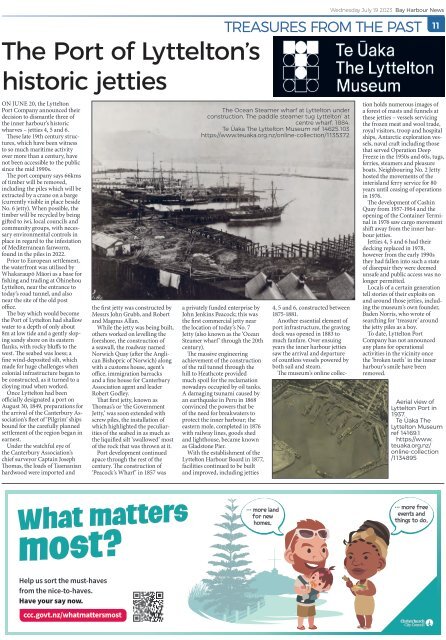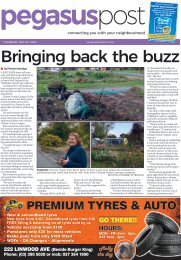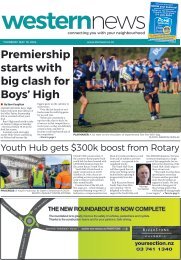Bay Harbour: July 19, 2023
Create successful ePaper yourself
Turn your PDF publications into a flip-book with our unique Google optimized e-Paper software.
The Port of Lyttelton’s<br />
historic jetties<br />
Wednesday <strong>July</strong> <strong>19</strong> <strong>2023</strong> <strong>Bay</strong> <strong>Harbour</strong> News<br />
TREASURES FROM THE PAST 11<br />
ON JUNE 20, the Lyttelton<br />
Port Company announced their<br />
decision to dismantle three of<br />
the inner harbour’s historic<br />
wharves – jetties 4, 5 and 6.<br />
These late <strong>19</strong>th century structures,<br />
which have been witness<br />
to so much maritime activity<br />
over more than a century, have<br />
not been accessible to the public<br />
since the mid <strong>19</strong>90s.<br />
The port company says 66kms<br />
of timber will be removed,<br />
including the piles which will be<br />
extracted by a crane on a barge<br />
(currently visible in place beside<br />
No. 6 jetty). When possible, the<br />
timber will be recycled by being<br />
gifted to iwi, local councils and<br />
community groups, with necessary<br />
environmental controls in<br />
place in regard to the infestation<br />
of Mediterranean fanworm,<br />
found in the piles in 2022.<br />
Prior to European settlement,<br />
the waterfront was utilised by<br />
Whakaraupō Māori as a base for<br />
fishing and trading at Ōhinehou<br />
Lyttelton, near the entrance to<br />
today’s road tunnel, and also<br />
near the site of the old post<br />
office.<br />
The bay which would become<br />
the Port of Lyttelton had shallow<br />
water to a depth of only about<br />
8m at low tide and a gently sloping<br />
sandy shore on its eastern<br />
flanks, with rocky bluffs to the<br />
west. The seabed was loess; a<br />
fine wind-deposited silt, which<br />
made for huge challenges when<br />
colonial infrastructure began to<br />
be constructed, as it turned to a<br />
cloying mud when worked.<br />
Once Lyttelton had been<br />
officially designated a port on<br />
August 30, 1849, preparations for<br />
the arrival of the Canterbury Association’s<br />
fleet of ‘Pilgrim’ ships<br />
bound for the carefully planned<br />
settlement of the region began in<br />
earnest.<br />
Under the watchful eye of<br />
the Canterbury Association’s<br />
chief surveyor Captain Joseph<br />
Thomas, the loads of Tasmanian<br />
hardwood were imported and<br />
the first jetty was constructed by<br />
Messrs John Grubb, and Robert<br />
and Magnus Allan.<br />
While the jetty was being built,<br />
others worked on levelling the<br />
foreshore, the construction of<br />
a seawall, the roadway named<br />
Norwich Quay (after the Anglican<br />
Bishopric of Norwich) along<br />
with a customs house, agent’s<br />
office, immigration barracks<br />
and a fine house for Canterbury<br />
Association agent and leader<br />
Robert Godley.<br />
That first jetty, known as<br />
Thomas’s or ‘the Government<br />
Jetty,’ was soon extended with<br />
screw piles, the installation of<br />
which highlighted the peculiarities<br />
of the seabed in as much as<br />
the liquified silt ‘swallowed’ most<br />
of the rock that was thrown at it.<br />
Port development continued<br />
apace through the rest of the<br />
century. The construction of<br />
‘Peacock’s Wharf’ in 1857 was<br />
The Ocean Steamer wharf at Lyttelton under<br />
construction. The paddle steamer tug Lyttelton’ at<br />
centre wharf, 1884.<br />
Te Ūaka The Lyttelton Museum ref 14625.103<br />
https://www.teuaka.org.nz/online-collection/1135372<br />
a privately funded enterprise by<br />
John Jenkins Peacock; this was<br />
the first commercial jetty near<br />
the location of today’s No. 7<br />
Jetty (also known as the ‘Ocean<br />
Steamer wharf’ through the 20th<br />
century).<br />
The massive engineering<br />
achievement of the construction<br />
of the rail tunnel through the<br />
hill to Heathcote provided<br />
much spoil for the reclamation<br />
nowadays occupied by oil tanks.<br />
A damaging tsunami caused by<br />
an earthquake in Peru in 1868<br />
convinced the powers that be<br />
of the need for breakwaters to<br />
protect the inner harbour; the<br />
eastern mole, completed in 1876<br />
with railway lines, goods shed<br />
and lighthouse, became known<br />
as Gladstone Pier.<br />
With the establishment of the<br />
Lyttelton <strong>Harbour</strong> Board in 1877,<br />
facilities continued to be built<br />
and improved, including jetties<br />
4, 5 and 6, constructed between<br />
1875-1881.<br />
Another essential element of<br />
port infrastructure, the graving<br />
dock was opened in 1883 to<br />
much fanfare. Over ensuing<br />
years the inner harbour jetties<br />
saw the arrival and departure<br />
of countless vessels powered by<br />
both sail and steam.<br />
The museum’s online collection<br />
holds numerous images of<br />
a forest of masts and funnels at<br />
these jetties – vessels servicing<br />
the frozen meat and wool trade,<br />
royal visitors, troop and hospital<br />
ships, Antarctic exploration vessels,<br />
naval craft including those<br />
that served Operation Deep<br />
Freeze in the <strong>19</strong>50s and 60s, tugs,<br />
ferries, steamers and pleasure<br />
boats. Neighbouring No. 2 Jetty<br />
hosted the movements of the<br />
interisland ferry service for 80<br />
years until ceasing of operations<br />
in <strong>19</strong>76.<br />
The development of Cashin<br />
Quay from <strong>19</strong>57-<strong>19</strong>64 and the<br />
opening of the Container Terminal<br />
in <strong>19</strong>76 saw cargo movement<br />
shift away from the inner harbour<br />
jetties.<br />
Jetties 4, 5 and 6 had their<br />
decking replaced in <strong>19</strong>78,<br />
however from the early <strong>19</strong>90s<br />
they had fallen into such a state<br />
of disrepair they were deemed<br />
unsafe and public access was no<br />
longer permitted.<br />
Locals of a certain generation<br />
tell stories of their exploits on<br />
and around those jetties, including<br />
the museum’s own founder,<br />
Baden Norris, who wrote of<br />
searching for ‘treasure’ around<br />
the jetty piles as a boy.<br />
To date, Lyttelton Port<br />
Company has not announced<br />
any plans for operational<br />
activities in the vicinity once<br />
the ‘broken teeth’ in the inner<br />
harbour’s smile have been<br />
removed.<br />
Aerial view of<br />
Lyttelton Port in<br />
<strong>19</strong>37.<br />
Te Ūaka The<br />
Lyttelton Museum<br />
ref 14169.1<br />
https://www.<br />
teuaka.org.nz/<br />
online-collection<br />
/1134895


















